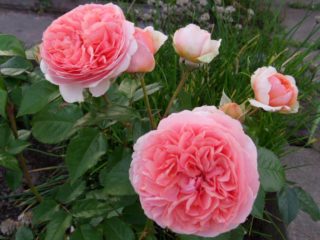Content
- 1 Description and characteristics of small petals
- 2 Types and varieties of small petals
- 2.1 Small petal (Erigeron acris)
- 2.2 Small-petaled compound (Erigeron compositus)
- 2.3 Beautiful small petal (Erigeron speciosus)
- 2.4 Karvinskian small petal (Erigeron karvinskianus)
- 2.5 Small petal daisy leaf
- 2.6 Erigeron aurantiacus
- 2.7 Small Petals Rose of July
- 2.8 Pink treasure
- 2.9 Azure Beauty
- 2.10 Erigeron hybrid Blau (Blau)
- 2.11 Small petals light blue
- 3 Reproduction methods
- 4 Conditions for growing small petals
- 5 Planting and caring for perennial small petals
- 6 Diseases and pests
- 7 Small petals in landscape design
- 8 Conclusion
Perennial small petal is an unpretentious, ornamental plant of the Asteraceae family. There are more than 200 varieties of culture in the genus, which have spread throughout the world.
Description and characteristics of small petals
The height of the bush in most varieties is up to 70 cm. The stems are thin, with varying degrees of branching. The spreading of the bush is average. The leaf blades are lanceolate or oval-shaped, bright green. The length of each leaf reaches 18-20 cm.
Most varieties have flowers similar in photo to daisies. In the small-petalled perennial, the buds are often single, although there are species in which the baskets are collected in inflorescences. The petals are elongated, united into cups. The color of the buds is varied: white, pink, yellow, lilac. The average size of each flower in diameter is 3 cm.
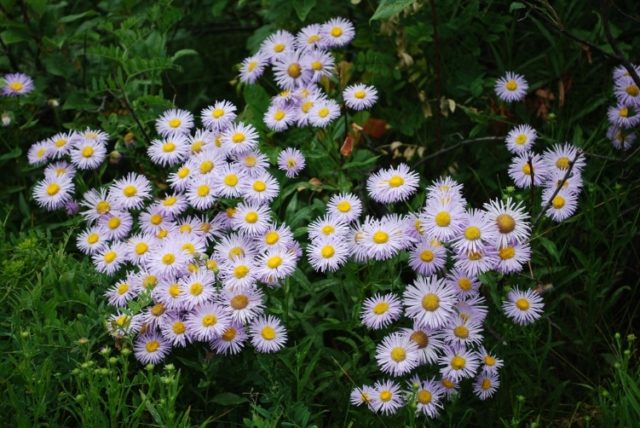
Depending on the variety, buds appear in early summer and fade in mid-autumn or after frost.
Types and varieties of small petals
A wide variety of varieties and types of erigeron allows you to choose the best option for your garden. Flower growers love small petals not only for their appearance, but also for their qualities: unpretentiousness, frost resistance.
Small petal (Erigeron acris)
A herbaceous plant with a fibrous root system. The height of the bush is 15-60 cm. The stems are straight, green with a reddish tint. The upper shoots branch. Leaf blades are lanceolate, pointed. The buds are collected in baskets - paniculate inflorescences.
The flowers are pale lilac along the edges of the panicle, and yellowish-green in the center. Flowering of the caustic small petal occurs in June-August.
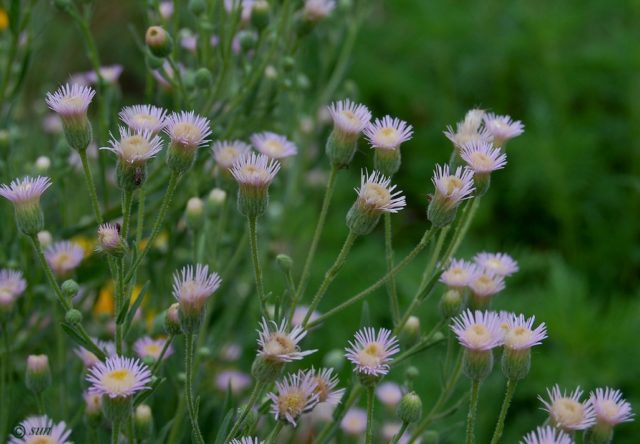
And although the chemical composition of the caustic species has not been studied, it is actively used in folk medicine, perennial erigeron is widespread everywhere, preferring meadows and forest clearings, forest edges
Small-petaled compound (Erigeron compositus)
The perennial is up to 15 cm in height, the bush spreads up to 10 cm in width. The leaf blades are trifoliate or in the form of 4 blades, gray-green in color.The buds are white or pink; there are varieties with pale blue baskets. The diameter of the inflorescence of the small petal compound is up to 2 cm.
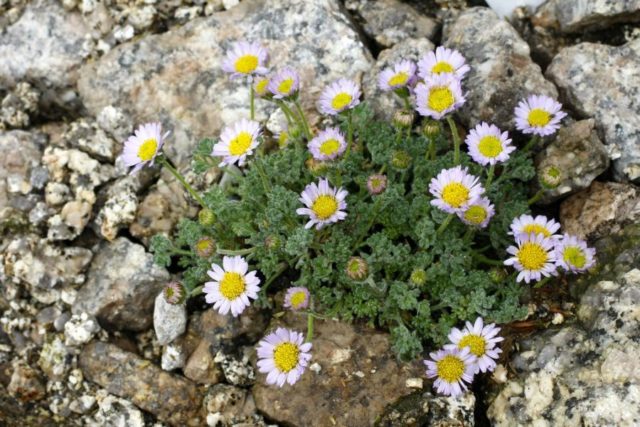
Perennial erigeron baskets bloom in July and fade with the onset of cold weather.
Beautiful small petal (Erigeron speciosus)
The perennial is taller than other types of erigeron: it reaches a height of 70 cm. The shoots are straight, slightly rough to the touch. The leaf blades are lanceolate and different in size: at the roots the foliage is larger than at the top of the bush. Flowers are collected in baskets.
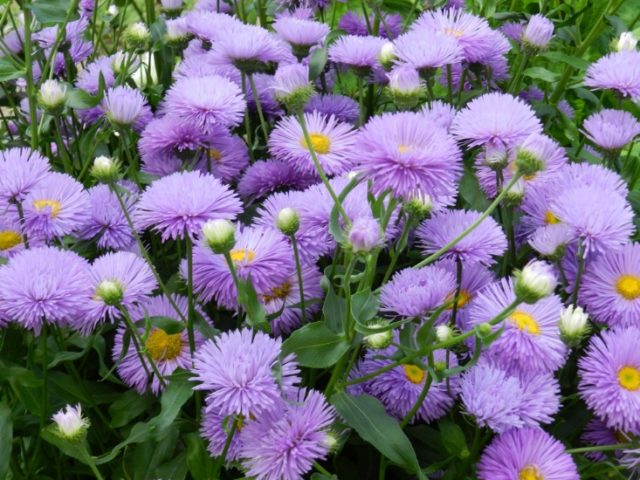
The beautiful small petal can have a heterogeneous color: white, in various shades of blue, pink or lilac
Karvinskian small petal (Erigeron karvinskianus)
The perennial is the best option for cultivation in hanging structures and flower beds. The height of the small-petaled Karvinsky Profusion reaches 15 cm. If the flower is allowed to grow freely, it can spread up to half a meter in diameter. Externally, the baskets of erigeron look like daisies.
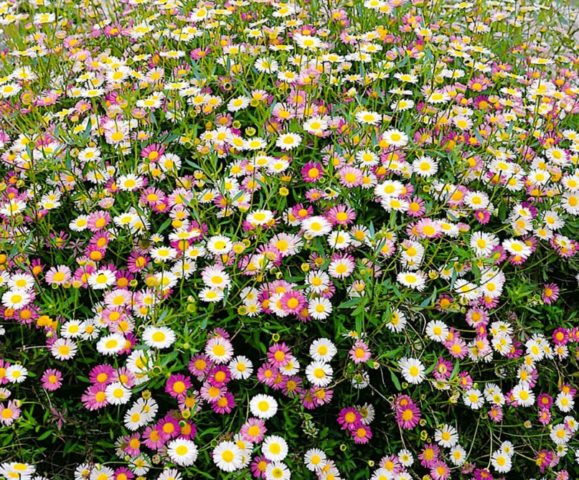
As soon as the Karvinsky bud opens, it is pink in color, but gradually its shade changes to white and then reddish
Small petal daisy leaf
The peculiarity of the variety is the color of the baskets. During the flowering period, the buds change color from pink to white, and then to a crimson hue.
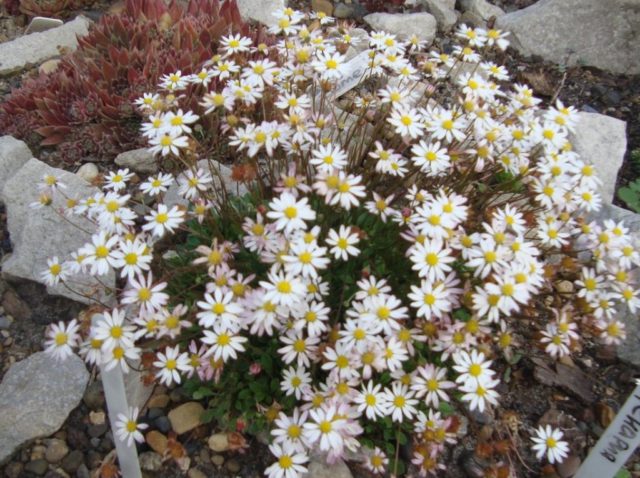
From a distance, the flower can be mistaken for a daisy, which is why the variety got its name
Erigeron aurantiacus
In nature, the plant can be found in northwest China or Central Asia.Its height reaches 0.4 m, the diameter of the bush grows to 0.5 m.
The stems are straight and have oval-elongated leaves. Inflorescences in the form of baskets reach 30 mm in diameter and have a rich orange color.
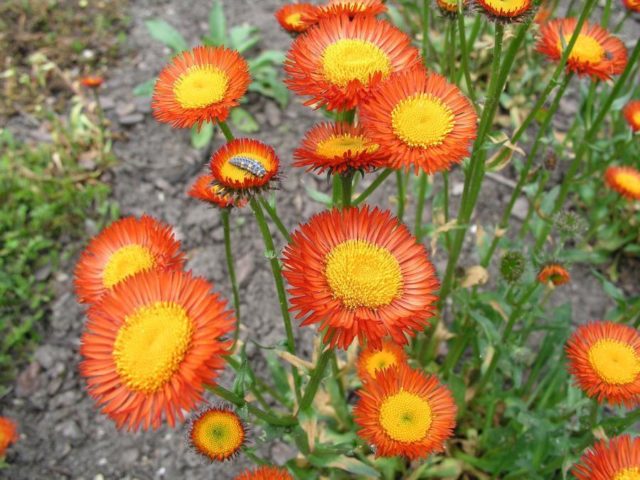
The orange variety has been cultivated by gardeners since 1879
Small Petals Rose of July
The perennial is photophilous and tolerates light shade. Plant height is 40-60 cm. Small petals bloom from April to September. Buds in the form of semi-double baskets, 3-4 cm in diameter. The color of the flowers is lilac-pink, with a yellow center.
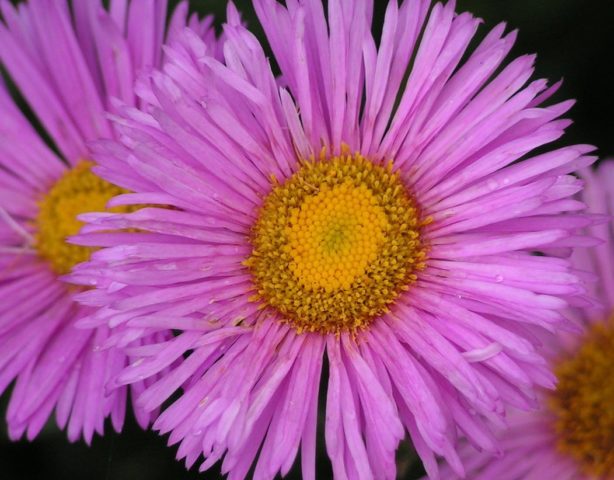
The Rose of July variety is suitable for cutting into bouquets and looks beautiful both in single plantings and in compositions
Pink treasure
Externally, the plant is very similar to an aster. The height of the bush is up to 70 cm. The inflorescences are open, rich pink with a yellow center. The small petal prefers sunny places. The flower does not tolerate stagnant moisture and shade.
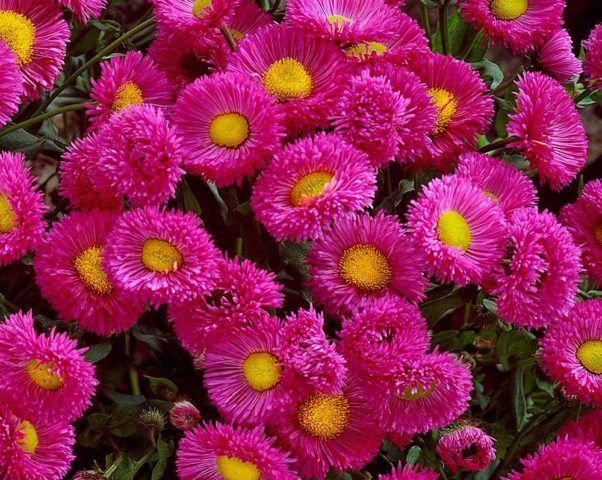
A distinctive feature of the Pink Treasure variety is that it blooms twice per season: from June to August, and then in September
Azure Beauty
The height of the variety is up to 70 cm, its shoots are densely leafy and straight. The flowers are baskets with a yellow core and small petals of lilac color with a purple tint. The small petal blooms abundantly and lasts from July to August.
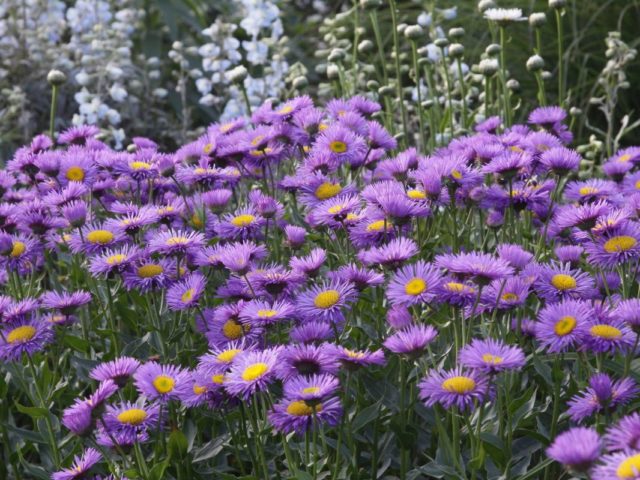
The variety is ideal for cutting, for planting in mixborders and flower beds
Erigeron hybrid Blau (Blau)
A bushy perennial with straight, branched shoots, up to 50 cm in height. The bush grows up to 75 cm in diameter. The leaf blades are narrow, the baskets are large, single, with a yellow core. The petals of Erigeron hybrid Blau are purple in color.
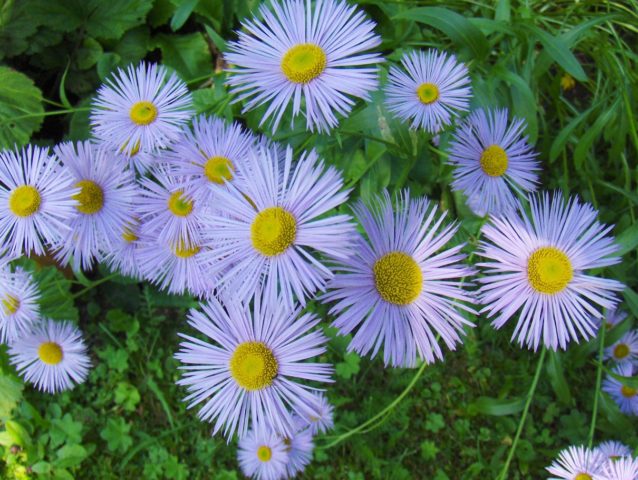
The variety is winter-hardy, prefers loose and moist soil, recommended for planting in mixed borders, on rocky hills
Small petals light blue
The perennial plant has an external resemblance to asters, but it has pubescent seeds. The height of the bush is up to 70 cm. The buds are 4-5 cm in diameter, the color of the petals corresponds to the name: light blue. The core of the small petal is yellow.
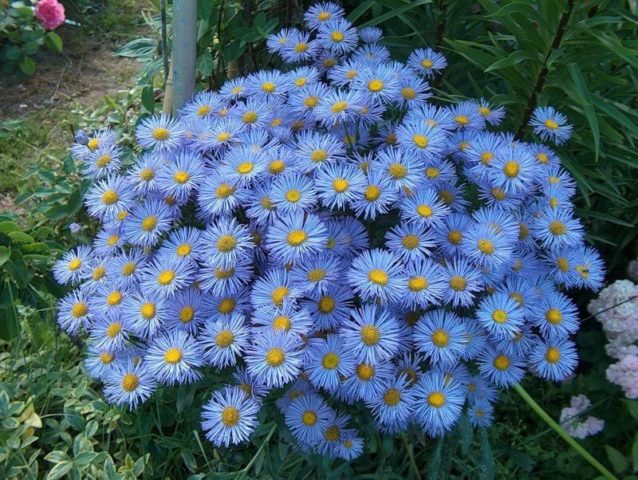
Erigeron perennial light blue blooms from June to October
Reproduction methods
The choice of propagation of perennial erigeron remains at the discretion of the gardener. Most centers sell seeds for sale. If there is a plant on the site, small petals can be propagated by cuttings or vegetative methods.
Reproduction of small petals by seeds
The optimal time for the procedure is March or April. Seeds do not germinate well, so most gardeners begin working with seed in late February or early March to give the seedlings a chance to get stronger.
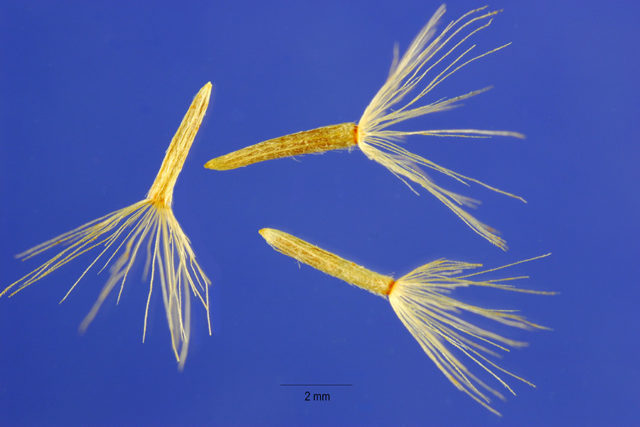
When purchased in specialized stores, seed treatment is not required; manufacturers disinfect them themselves
When growing small petals from seeds, young seedlings are transferred to a permanent place in early May. Planting erigeron in open ground in April is possible for the southern regions or if gardeners have a greenhouse.
Vegetative method
The method is relevant if adult bushes of perennial erigeron grow on the site for 3-4 years. The method involves dividing the bush into several parts and then replanting it in a new location.
The optimal time for the procedure is the last month of summer and the first half of September.
Cuttings
It is necessary to separate the young shoots with part of the rhizome from the perennial erigeron bush. Place the shoot in garden soil and sprinkle with sand and wood shavings and water. As soon as the small petal takes root and begins to grow, it should be moved to a permanent place.
Conditions for growing small petals
Erigeron perennial prefers alkaline soils. The flower can also grow on loam or neutral soils, without stagnant water.
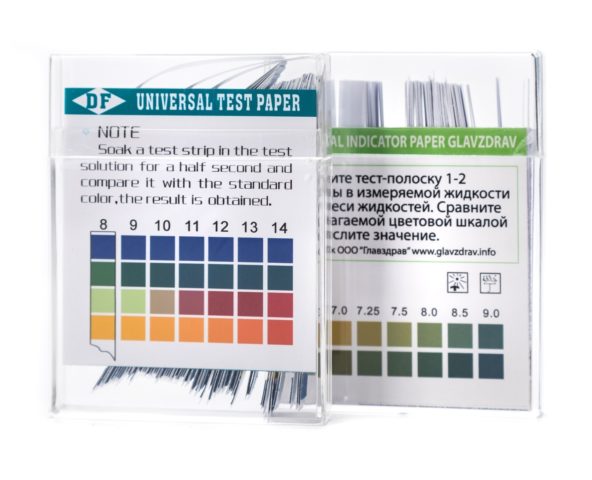
To determine the acidity of the soil, you can use indicator paper
The planting site should be well lit, with a slight draft allowed. With excess moisture and lack of light, perennial erigeron grows poorly and is prone to disease.
Planting and caring for perennial small petals
The main method of planting is sowing seeds. For those who want to achieve early flowering, it is recommended to use the seedling method. Perennial erigeron grows safely when planted with seeds in open ground.
When to sow seeds
The material can be sown both in spring and autumn. In February-March, the seeds are used to produce seedlings. Before winter, the material is sown directly into open ground. The choice of planting time depends on personal preferences and the variety: if the selected species does not germinate well, then it is better to use the seedling method.
Sowing seeds and subsequent care
To plant seedlings in a prepared container, you need to pour soil, moisten it, then distribute the seeds over the surface of the soil, planting them to a depth of 0.5 cm, pressing lightly with your finger.
Cover the container with film and transfer to a warm windowsill. Shoots appear after 30 days. As soon as the seeds hatch, the film should be removed.
Further care consists of watering the erigeron, picking it and replanting it in open ground.
If a decision is made to plant seeds directly into the soil, then the procedure should be carried out in warm, calm weather.
Planting principles:
- dig up the bed, level the soil;
- make furrows, maintaining a distance of 25-30 cm between them;
- Place the seeds to a depth of 1 cm, cover with soil and a layer of mulch.
When seedlings appear, it is necessary to thin out the plants, leaving a distance of at least 10 cm between them.
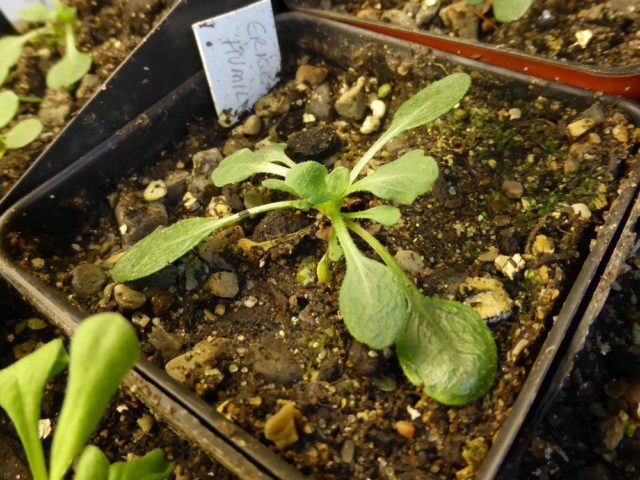
When the plants get stronger, they can be planted
Further care of the plant is simple: loosening the soil and watering. It should be borne in mind that excess water is detrimental to perennial erigeron. To reduce watering, just mulch the soil around the flower with sawdust.
Due to the abundant flowering of perennial erigeron varieties with long shoots, the branches may bend to the ground. It is recommended to install support for such bushes.
It is recommended to cut off faded shoots so that the perennial petal will look neater. It should be borne in mind that when pruning, the bush will grow more luxuriantly next year.
And although erigeron is a perennial frost-resistant plant, the soil around it should be mulched with dry leaves.
Diseases and pests
The flower is susceptible to mold, so it should not be watered too often. To prevent the occurrence of the disease, it is necessary to treat with fungicides during flowering. It is allowed to irrigate the bush with a 1% solution of Bordeaux mixture.
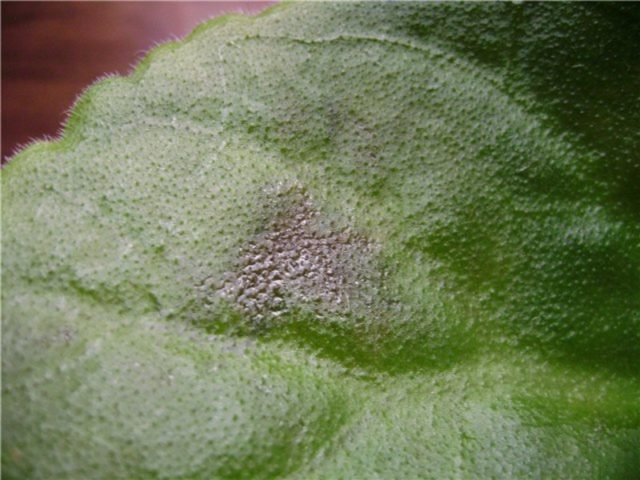
If signs of disease are detected on the shoots, the soil should be loosened and all affected parts of perennial erigeron should be removed.
Small petals in landscape design
In open ground, gardeners prefer to plant perennial erigeron in company with zinnias, yarrow, ursinia and others. The flower looks good with sage and lobelias.
They can be placed on the site in various places: along paths, in rock gardens, hanging flower pots.
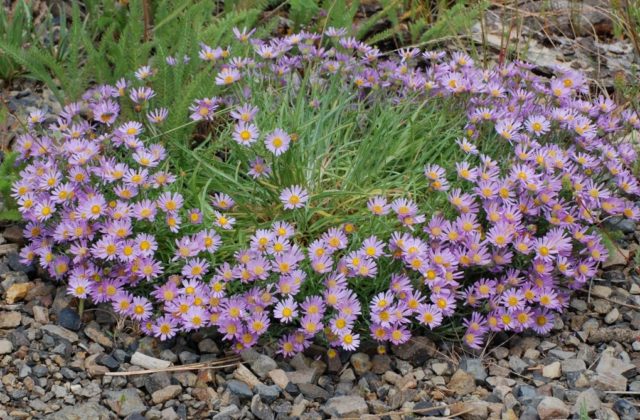
Low-growing varieties are preferably placed in the foreground
Perennial erigeron is placed as a background in flower beds if the variety is tall. It is recommended to use heuchera, daisies and gaillardia as companions.
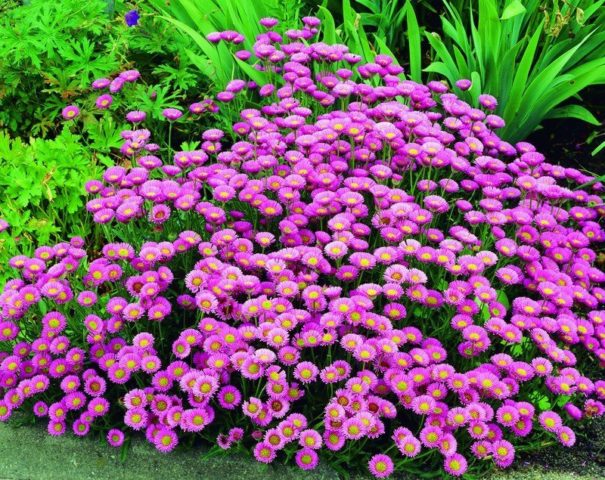
When choosing a site, you should take into account that the plant grows, so in the garden you can create multi-colored “carpets” of small-petalled perennial
Conclusion
Perennial small petal is one of the most successful flowers for creating landscape design. A long flowering period and bright, varied colors of buds, ease of care, and the ability to grow in one place for up to 5 years are the main qualities of the crop. The disadvantage of perennial erigeron is that it is difficult to plant; the seeds take a long time and do not germinate well.







